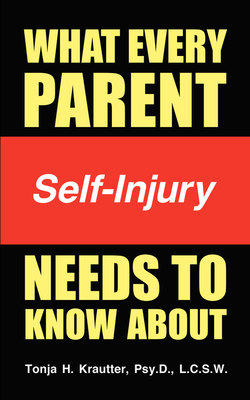Читать книгу What Every Parent Needs to Know About Self-Injury - Tonja Krautter - Страница 3
На сайте Литреса книга снята с продажи.
ОглавлениеWhat is Self-Injury?
“When I cut, I want to draw blood. When I break, I want something to shatter. I want a trail that marks my pain.” - Amber, age 18
Self-injury, also known as self-mutilation, self-harm, or cutting, is a largely misunderstood condition that affects millions of people. It is a growing epidemic in our society and one that cannot simply be written off as teenage angst. Both teenagers and adults suffer from self-injurious behavior, and the number is on the rise. With a reported two million cases in the United States alone, this disorder has become rampant.
A Physical Expression of Emotional Pain
The formal definition of self-injury was created by Karen Conterio and Wendy Lader, authors of Bodily Harm: The Breakthrough Healing Program for Self-Injurers (Hyperion, 1986). They write, “It is the deliberate mutilation of the body or a body part, not with the intent to commit suicide but as a way of managing emotions that seem too painful for words to express.” The following quote from a patient in their book captures this sentiment succinctly: “How will you know I am hurting, if you cannot see my pain? To wear it on my skin, tells what words cannot explain.” - C. Blount
Other patients concur with the idea that self-injury is a way to express physically what they cannot express verbally. Some patients cannot express their sadness while others cannot express their anger. Rebecca, who began cutting herself six months ago, concretely explains the reasons behind this behavior. She says, “Cutting became my cry for help when words could not do it for me. I wanted people to see how ugly I was, and how ugly I felt. I was tired of trying to explain how much I hurt on the inside. I wanted it to show it on the outside.” Rebecca is experiencing great sadness. She is looking for a way to prove to others and to herself that her pain is real. She has difficulty expressing her pain (sadness) verbally, so she chooses to express it physically.
Stephanie illustrates this point as well. However, Stephanie is experiencing tremendous anger. She just turned eighteen and states, “I cannot believe I am now officially an adult. Not much has changed. Certainly not the way I feel about myself. Hate is a powerful feeling. It rises within me, there is no ceiling. I mark myself to show my pain. I do not yell and I never scream. I hold it all in and let it consume me. Then the pain comes. It flows through me - slow, smooth, gradual - always consuming. This feeling is much more tolerable than hate.”
There are many reasons individuals self-injure, which we will discuss at great length later in this book. The two examples above give a small glimpse of how different emotions can lead to the addictive process of self-injury. Individuals use self-injurious behavior as a way to cope with their distressing emotions. The one common denominator is typically the individual’s difficulty with verbal self-expression. Without this ability, the person is left with a physical means of communication.
